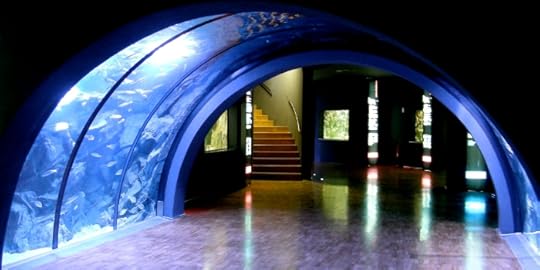Mermaids in Milan
I know, I know, it’s hot.
And if you’re still in Milan — maybe marooned here because of a project that just couldn’t wait or simply because life sucks or because, on the contrary, you enjoy the empty city just as I do — I’ve got you covered: this week we go hunting for mermaids.
Yes, mermaids. Not sirens in the classical sense — the ones from Homer who were actually part bird, part woman, and perched on rocky outcrops crooning sailors to their doom — but honest-to-goodness fish-tailed, shimmering, sea-bound mermaids. The kind that emerged from medieval bestiaries and Renaissance curiosities, evolved into Art Nouveau fantasies, and eventually found their way into public fountains, museum vitrines, and the wrought iron of a charming 19th-century bridge.
This month’s itinerary is a gentle escape — part scavenger hunt, part city dérive — tracing the slippery silhouette of mermaids through Milan’s stone, bronze, canvas, and myth. We’ll start with public art: fountains where marine deities still frolic, bridges watched over by cast-iron sirens, and the aquarium’s Liberty façade swimming in decoration. Then we’ll dive indoors, visiting museums that harbour actual mermaid specimens (well, amost), mythic gods of the sea, and ancient interpretations of the siren myth.
Whether you’re looking for a cooling distraction, a whimsical lens on the city, or just a good excuse to end your day with a dive in a swimming pool, this is a route of fantasy, fluidity, and feminine mystery, hidden in the cracks of Milan’s stone. Bring your bathing suit.
1. Ponte delle Sirenette – The Mermaids BridgeAddress: Parco Sempione, Milan
This bridge features four cast-iron mermaid statues, possibly the most famous mermaids in Milan.
The Ponte delle Sirenette, or “Bridge of the Little Mermaids,” is a charming cast-iron pedestrian bridge nestled within Parco Sempione. Originally constructed in 1842 by engineer Francesco Tettamanzi, it was the first iron bridge in Italy. Commissioned for the Naviglio in Via San Damiano (now Via Visconti di Modrone, with no Naviglio), the bridge was adorned with four cast-iron mermaid statues, each holding an oar. These statues were affectionately nicknamed the “Ghisini Sisters,” a playful nod to the material “ghisa” (cast iron) used in their creation.
 A 1905 picture
A 1905 pictureIn 1930, following the covering of the Navigli canals, the bridge was relocated to its current picturesque setting in Parco Sempione, spanning a serene artificial lake. The mermaid statues, with their flowing hair and dual tails, evoke the mythical Melusine and have become symbols of romance and allure. Over the years, the bridge has been a favoured spot for couples, with legends suggesting that a kiss beneath the mermaids ensures eternal love.
Despite suffering damage during World War II and the theft of one statue in 1948, the bridge was restored in 1954, with two of the mermaids recast in bronze. Today, the Ponte delle Sirenette stands as a testament to Milan’s rich blend of art, history, and mythology, offering visitors a whimsical glimpse into the city’s romantic past.
 2. Acquario Civico di Milano
2. Acquario Civico di MilanoAddress: Viale Gadio 2, 20121 Milano
The Acquario Civico di Milano stands as a testament to Milan’s love of aquatic themes in art and architecture. As my grandfather used to say: we don’t have the sea anymore, but we still have the fish market. Its Liberty-style façade is adorned with marine motifs, including a prominent statue of Neptune, the Roman god of the sea, and it’s good for an afternoon in the shadows.
Inaugurated in 1906 for the Milan International Exhibition, the Acquario Civico is the only surviving pavilion from the event. Designed by architect Sebastiano Locati, the building is a prime example of Milanese Liberty architecture. Its façade features decorative elements such as floral majolica tiles by Richard-Ginori and aquatic-themed cement reliefs by the Chini company. Central to the façade is a statue of Neptune, crafted by sculptor Oreste Labò, under which a fountain with a hippopotamus head spouts water.

Inside, the aquarium offers a journey through various aquatic environments, from alpine streams to marine depths, showcasing over 100 species across 36 tanks. The building also hosts temporary exhibitions that blend art and marine science, further enriching the visitor experience.
 3. Portrait of Andrea Doria as Neptune by Agnolo Bronzino
3. Portrait of Andrea Doria as Neptune by Agnolo BronzinoLocation: Pinacoteca di Brera, Via Brera 28, Milan
This allegorical portrait transforms the Genoese admiral Andrea Doria into Neptune, the Roman god of the sea, embodying the fusion of maritime power and mythological symbolism. It’s housed in one of our most beloved art galleries: the Pinacoteca di Brera.
 The inner courtyard
The inner courtyardPainted circa 1545–1546 by Agnolo Bronzino, this oil on canvas measures 115 × 53 cm and is housed in Room XXVII of the Pinacoteca di Brera. Commissioned by Paolo Giovio for his collection of portraits of illustrious men, the artwork presents Andrea Doria in heroic nudity, standing beside a ship’s mast with his genitals modestly concealed by a sail. Originally, Doria held an oar, symbolising his command over naval forces, but it was later altered to a trident, aligning him more directly with Neptune.
Bronzino’s portrayal is notable for its idealisation of Doria’s physique, reflecting the Mannerist style’s emphasis on elegance and refinement. The painting’s composition, with Doria’s body turned to the left and his gaze directed to the right, conveys both strength and contemplative authority.
 4. Fontana dei Tritoni
4. Fontana dei TritoniAddress: intersection of Via Andegari and Via Romagnosi, 20121 Milan
The Fontana dei Tritoni, completed in 1928, was a collaborative work between architect Alessandro Minali and sculptor Salvatore Saponaro. Commissioned by the Cassa di Risparmio delle Provincie Lombarde, the fountain was designed to adorn the bank’s new headquarters. Its classical temple-like structure houses two allegorical female figures: one representing “Risparmio” (Savings), and the other “Beneficenza” (Charity). The central feature is a large shell supported by two tritons, from which water gracefully flows. Milanese locals affectionately (and grossly) nicknamed the statue of “Risparmio” as “la dòna di tri tètt” (the woman with three breasts) due to the positioning of the piggy bank. The fountain’s inscriptions, such as “Sacrum sita es publicum” (May this public structure be sacred), illustrate the significant gap between intention and implementation in public places in Milan.

At the heart of the fountain, beneath a large shell-shaped basin, two muscular tritons rise from the base, mythological sea creatures with the torso of a man and the tail of a fish. They are entwined in a spiralling posture, their arms raised to support the conch above them, from which water spills down in fine rivulets. Their expressions are stylised and solemn, evoking the grandeur of classical sculpture, yet their forms are baroque in energy. Despite their mythological origins, these tritons are not the youthful, graceful figures one might associate with Greek art: they appear rugged, weather-worn, and almost grotesque. Their fish tails coil around each other in a dynamic, almost serpentine movement, adding a sense of vitality and motion to the otherwise static stone façade.
5. Fontana del PiermariniAddress: Piazza Fontana, 20122 Milano
Inaugurated on August 15, 1782, the Fontana del Piermarini was designed by architect Giuseppe Piermarini (the Scala one) and sculpted by Giuseppe Franchi. Crafted from pink Baveno granite, the fountain comprises three superimposed basins of decreasing size. Water cascades from the top basin into the middle one, which rests on a sculptural group featuring two dragon-like creatures carrying the sirens, before flowing into the larger lower basin and finally emerging through four spouts into corresponding small basins at ground level.
The two marble sirens, affectionately known as “Le Teodolinde” by locals, were added in 1783. These figures, seated atop dolphins, are notable for their expressive features and the intricate detailing of their flowing hair and scales, embodying the neoclassical style of the period . The fountain not only serves as an artistic centrepiece but also reflects Milan’s historical efforts to modernise its urban landscape during the late 18th century.
 6. Museo di Storia Naturale di Milano
6. Museo di Storia Naturale di MilanoAddress: Corso Venezia 55, 20121 Milano
This museum houses the enigmatic “Sirena di Milano,” a unique artefact that’s obviously a fake but it’s a charming one. Well, no, it’s horrid, but you’ll enjoy it anyway.

Nestled within the Museo di Storia Naturale di Milano is a curious artefact known as the “Sirena di Milano.” Discovered in the 1980s by palaeontologist Giorgio Teruzzi, this small artefact measures approximately 30 centimetres in length and presents a fascinating amalgamation of features: a humanoid torso with human hair, bird-like claws, and a fish-like tail. While radiographic analyses have confirmed it as a fabricated specimen — constructed with materials such as wood, iron, organic leftovers and papier-mâché — the artefact remains a captivating example of 19th-century curiosities that captivated the public imagination.
The actual origins of the Sirena di Milano are shrouded in mystery, while it’s easy to point fingers at Teruzzi himself. It’s speculated that the piece may have been part of a donation from the Villa brothers, Milanese collectors who contributed various items to the museum’s collection.

In addition to this intriguing exhibit, the museum is currently hosting “The Living Sea,” a photographic exhibition by Hussain Aga Khan. Running until September 5, 2025, the exhibition offers a mesmerising glimpse into the extraordinary biodiversity of oceans around the world, further enriching the maritime theme of our itinerary.
 7. Bagni Misteriosi
7. Bagni MisteriosiAddress: Via Carlo Botta 18, 20135 Milano
Too far to go on foot. From Porta Venezia take the Underground (Red Line till Duomo, then Yellow Line till Porta Romana)
The Bagni Misteriosi, originally known as the Piscina Caimi, were inaugurated in 1939 as part of a multifunctional sports complex designed by architect Luigi Secchi. After years of closure, the site underwent a significant restoration led by Andrée Ruth Shammah, reopening in 2016 as a cultural hub integrated with the Teatro Franco Parenti. The name “Bagni Misteriosi” draws inspiration from Giorgio de Chirico’s 1973 surrealist sculpture-fountain of the same name, reflecting the venue’s commitment to blending art, performance, and community engagement.
 What’s left of De Chirico’s statues for the original installation are on display at Museo del Novecento but that’s no mermaid: just a fish.
What’s left of De Chirico’s statues for the original installation are on display at Museo del Novecento but that’s no mermaid: just a fish.Today, the Bagni Misteriosi feature a large swimming pool, a smaller children’s pool, lush green spaces, and versatile areas suitable for events and performances. During the summer months, the venue hosts a variety of activities, including theatre productions, concerts, and open-air cinema, often utilising the pool itself as a stage. This dynamic use of space creates an immersive experience that resonates with our tour, and it’s the perfect ending. After all, I said it’s hot.




